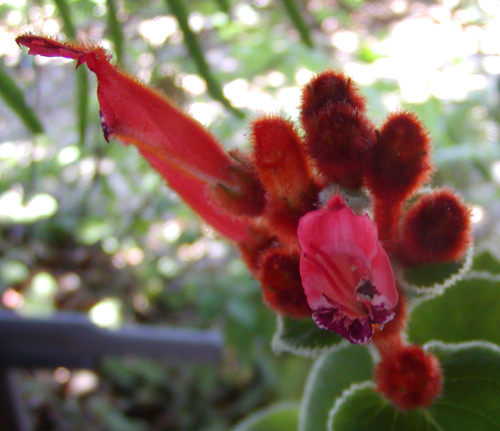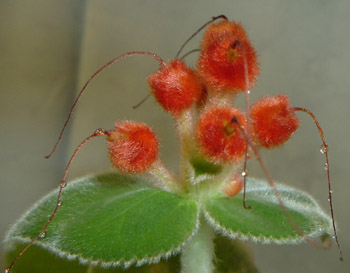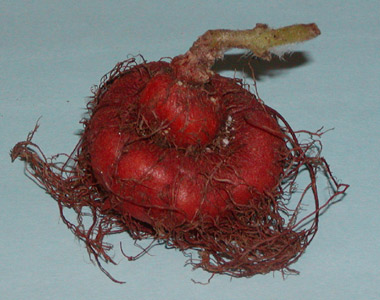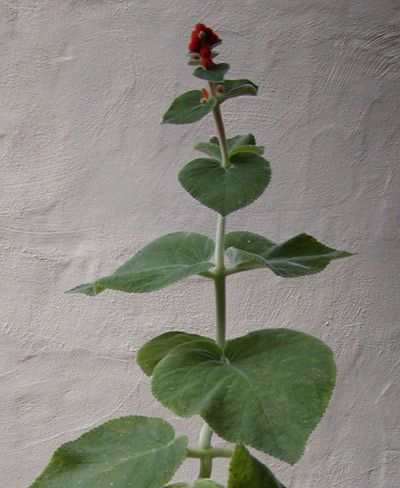Sinningia globulosa
This species is remarkable for the matted white hairs covering the stems and the undersides of the leaves. The tops of the leaves are cardinalis-green.

| Species list |
Hybrids list |
Tubers list |
Topics list |
Site index |
What's new |
Home page |
Sinningia globulosaThis species is remarkable for the matted white hairs covering the stems and the undersides of the leaves. The tops of the leaves are cardinalis-green. |

|

|
Karyn Cichocki took the picture to the left, of her own plant. Note the beads of nectar on the styles. The flowers are borne at the top of a tall stem (my plant was 63 cm [25 inches] tall when it began to bloom in August 2009). The flowers have a galea, which can be seen in the picture at the top of the page. The lower three lobes have a purple fringe around the mouth of the corolla, similar to the blotch or fringe found in several other galeate species, like its close relative S. hatschbachii. |
FruitThe calyxes are densely covered with red hairs, which persist even after the corolla drops, at which time the calyx lobes fold inward to enclose the developing fruit, with only the spent style protruding from the narrow opening. This feature, which can be seen in the picture above, creating a sort of ball-shaped fruit, is the source of the name globulosa ProblemsIn many cases, the plant seems to form buds which never open. When this happened to my plant, I believed that some bug had burrowed inside the flowerbud and damaged it. However, the buds-that-didn't-open problem has been reported by others on the Gesneriphiles mailing list. Among them were Toshijiro Okuto, in Japan, and Carolyn Ripps in New York state (USA). This makes it more than likely that the problem is not a predator local to one area, but a weakness in the plant itself. Either its buds are finicky about opening, a trait that appears to a lesser degree in its close relative Sinningia hatschbachii, or the pest which attacks the flowerbuds has friends all over the world. A lesser horticultural difficulty is that the plant grows either tall or wide, depending on its situation. It is not well suited for a growing situation where space is at a premium. |

|
TuberThe tuber of Sinningia globulosa is a reddish brown reminiscent of the tuber of S. hatschbachii. Alain Chautems has confirmed that new DNA studies show that S. globulosa and S. hatschbachii are very closely related. |

|
HeightHorticulturally speaking, the plant has a height problem. It's too tall for the number of flowers. Judging by this plant, at least, it's too big to grow under lights with any expectation of bloom. Then again, this particular individual may not be typical. Other plants may be more compact. |
| Plant Description |
|
| Growth | Indeterminate |
| Habit | Upright grower, usually with multiple stems |
| Leaves | Cardinalis-green on top; covered with white hairs underneath |
| Dormancy | |
Flowering |
|
| Inflorescence | Two flowers per axil on extended axis |
| Season | Summer |
| Flower | Red, with galea. Purple fringe around corolla mouth (lower three lobes). Calyx is densely covered with red hairs, and closes up after corolla drops. |
Horticultural aspects |
|
| Hardiness | Has survived 34 F (1 C) in my back yard |
| From seed | 3 years, under my conditions |
| Recommended? | Well, the flowerbuds are very attractive, and I like the tuber too. But the whole plant isn't so impressive, even in bloom. There's a cluster of a few flowers at the top of a tall stem. That and the long wait for it to bloom make me give this plant a reluctant thumbs down, for the moment. In future years, however, the plant may improve in compactness or floriferousness. |
Botany |
|
| Fruit | Ball-shaped with a short beak. Almost entirely enclosed by calyx, which is covered by reddish hairs. See picture above. |
| Taxonomic group | The galea group of the Dircaea clade. Closely related to S. hatschbachii. |
| Location | Serra do Mar in São Paulo state, Brazil. |
See Mauro Peixoto's Brazilian Plants site for a page about S. globulosa.
Chautems in Candollea, 2010.